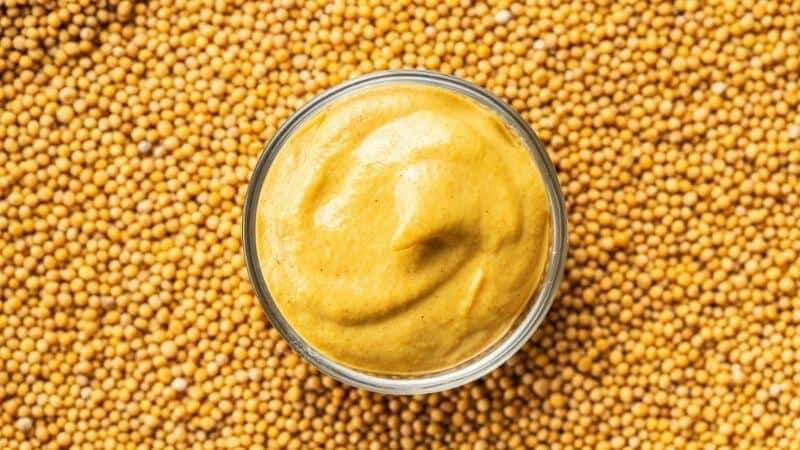If you’ve ever taken a big bite of a hot dog covered in mustard and felt a fiery sensation shoot up your nostrils, you’re not alone. But what causes this common condiment to burn your schnoz?
The key culprit is a volatile compound called allyl isothiocyanate. When you eat mustard, this chemical is released from the seeds and turns into a vapor that irritates your nasal cavity. It activates special receptors in your nose that create the inflammatory response you feel as a burning sensation.
In this article, we’ll explore the science behind why mustard burns your nose. We’ll look at:
- The key compounds in mustard that cause the burning sensation
- How those compounds interact with your nose
- Why you feel the burn more in your nose than on your tongue
- Whether mustard burns your nose the same way as chili peppers
By the end, you’ll understand exactly why mustard makes your nose feel like it’s on fire!
The Key Culprit Behind Mustard’s Nose Burn
The main chemical compound responsible for mustard’s intense nasal burn is allyl isothiocyanate. This volatile oil is produced when mustard seeds are crushed during the preparation process.
Here’s why allyl isothiocyanate leads to that flaming sensation in your schnoz:
- It evaporates quickly into a vapor when exposed to air
- The vapors easily travel up into your nasal passages when you eat mustard
- It irritates the mucous membranes lining your nose
This causes the release of inflammatory mediators that make your nose feel like it’s burning from the inside out.
So in essence, allyl isothiocyanate turns your nose into a mustard gas chamber!
Why Your Nose Burns More Than Your Tongue
If allyl isothiocyanate is causing the burning sensation, why don’t you feel it as strongly on your tongue?
There are two key reasons:
1. More Receptors in Your Nose
Your nasal cavity contains a high concentration of TRPA1 receptors. These receptors are activated by allyl isothiocyanate.
When the vapor travels up your nostrils, it binds to these TRPA1 receptors. This triggers them to send pain signals to your brain, creating that burning feeling.
Since your tongue has fewer of these mustard-sensitive TRPA1 receptors, you experience less burn in your mouth.
2. Rapid Evaporation
Allyl isothiocyanate evaporates quickly at room temperature. This allows it to turn into a vapor and make its way towards your nasal cavity before it gets the chance to fully activate receptors on your tongue.
So by the time the mustard reaches your mouth, there’s less of the volatile compound left to cause irritation. Most of it has already steamed up into your nostrils like a mustard sauna!
Not All Mustards Burn Equally
While allyl isothiocyanate is present in all mustards, the intensity of burn can vary based on:
- Type of mustard seed – Some seeds like brown mustard contain more of the volatile compound than others.
- Preparation method – The way the seeds are crushed and processed impacts how much allyl isothiocyanate is released.
- Additional ingredients – Adding other spices and acids like vinegar influences the overall nasal burning effect.
This explains why you might find Dijon mustard to be more nose-tickling than yellow mustard. The amount of volatile oils released differs based on the recipe.
Is Mustard Nose Burn the Same as Chili Pepper Mouth Burn?
You might be wondering if the nasal flame from mustard is caused by the same mechanisms as the oral inferno from chili peppers.
While both can set your senses ablaze, there are some key differences:
- Mustard burns your nose through allyl isothiocyanate binding to TRPA1 receptors.
- Chili peppers burn your mouth through capsaicin binding to TRPV1 receptors.
So they activate different receptors and use different chemical compounds to do so.
There are also differences in:
- Location – Peppers mainly hit your tongue and mouth while mustard goes straight for your snout.
- Duration – Mustard nose burn starts fast but fades quick while chili mouth burn builds slowly and lingers.
- Volatility – The pepper compound (capsaicin) stays put while the mustard compound (allyl isothiocyanate) vaporizes rapidly.
So while they both can set your face aflame, mustard and chili peppers do so through distinct mechanisms. Think of mustard as an uppercut to your nostrils and chili peppers as a drawn-out mouth inferno.
Why Does Mustard Burn if It’s Meant to Repel Us?
If mustard’s burning sensation is meant to warn us away from eating it, why do so many people enjoy the kick?
Scientists think this nose-tingling contradiction comes down to the fact that:
- We’ve acquired a taste for certain types of irritation and pain over our evolutionary history.
- The burn is mild enough that we associate it with other pleasant flavors in the dish.
- When eaten in small amounts, the allyl isothiocyanate provides a thrilling sensation without being overpowering.
Our desire for that mustard nose burn highlights the complex interplay between sensory irritation and hedonic reward. We’ve learned to enjoy chemical compounds that our senses originally perceived as warnings.
Health Effects of Allyl Isothiocyanate
While known best for making your nose burn, allyl isothiocyanate may also have some health benefits when consumed in the small amounts found in mustard.
Research suggests the compound has:
- Antioxidant effects – Allyl isothiocyanate displays free radical scavenging activity, meaning it may help reduce oxidative stress in the body.
- Anti-inflammatory effects – Studies show it can inhibit release of certain pro-inflammatory mediators and enzymes. This may contribute to reducing inflammation.
- Cancer-fighting properties – Test tube and animal studies indicate allyl isothiocyanate may support apoptosis (programmed cell death) in cancer cells. It also appears to activate certain detoxification enzymes.
However, most research has been limited to laboratory or animal models so far. More clinical studies are needed to verify if allyl isothiocyanate has the same protective effects in humans.
While the nasal-burning component of mustard may be biologically beneficial, keep in mind these potential health perks have only been observed in moderation. High doses of allyl isothiocyanate could cause unwanted irritation and toxicity.
So feel free to enjoy that mustard nose tingle, but don’t go overboard in hopes of maxing out the health benefits! Mild is key when it comes to mustard consumption.
Conclusion: Embrace the Nose Burn
Hopefully this article shed some light on why mustard makes your nostrils feel like they’re on fire. To recap:
- The main culprit is allyl isothiocyanate, a volatile compound found in mustard seeds.
- When you eat mustard, this chemical vaporizes and travels up into your nasal cavity.
- It activates TRPA1 receptors in your nose, triggering inflammatory effects.
- You experience less burn on the tongue because there are fewer receptors.
So next time you grab a hot dog or pretzel with mustard, embrace the nose burn instead of being surprised by it. Think of it as the zingy signature of this beloved condiment. Just grab a tissue in case your nostrils start running!
Sources
- Reddit: ELI5: Why does hot mustard burn in nose and not the mouth like hot chili? : r/explainlikeimfive
- Biology Stack Exchange: What is the biochemical explanation for tingling and burning sensation in brain due to certain food?
- ScienceDirect Topics: Allyl Isothiocyanate – an overview
- PubChem: Allyl isothiocyanate | C4H5NS
- US Pharmacist: Capsaicin: Risks and Benefits





